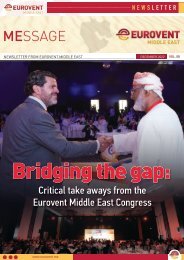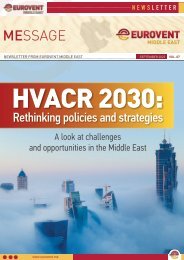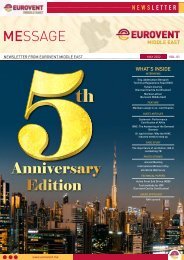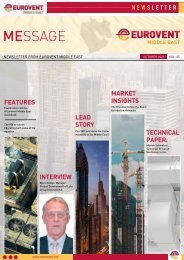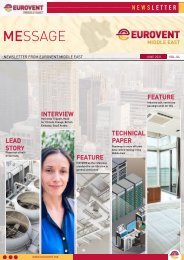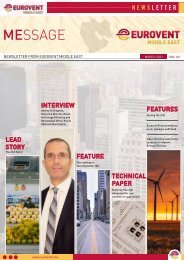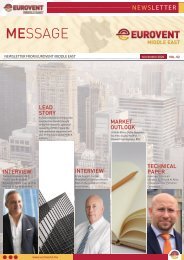EME Newsletter MEssage #01/2023
HVACR Industry news from Eurovent Middle East
HVACR Industry news from Eurovent Middle East
Create successful ePaper yourself
Turn your PDF publications into a flip-book with our unique Google optimized e-Paper software.
NEWSLETTER<br />
FEATURE ARTICLE<br />
building syndrome, saving between<br />
USD 10 and 100 billion US dollars;<br />
8 to 25% fewer asthma-related<br />
absences, saving USD 1 to 4 billion;<br />
23 to 76% reduction in respiratory<br />
diseases, saving USD 6 to 14 billion<br />
and productivity increases of 0.5 to<br />
5% for office workers, generating<br />
gains of USD 20 to 200 billion.<br />
A valuable yet underutilised tool<br />
Given the holistic benefits of<br />
quality air filters, consultants and<br />
project owners must choose the<br />
most optimum filters for their<br />
respective facilities. This may not<br />
always be straightforward, given<br />
that each project is different, and<br />
many solutions are available in the<br />
market. “Filters look the same<br />
from the outside, but the way they<br />
behave from one to another can<br />
present many differences,” says<br />
Ruiz. “It is crucial for consultants to<br />
understand the effect and benefits<br />
of the filters on the HVAC system,<br />
and its impact on sustainability,<br />
energy use, waste disposal and<br />
occupant health.”<br />
Eurovent offers excellent guidance<br />
for consultants and project owners<br />
to navigate the thin line between<br />
energy efficiency and filtration<br />
requirements. The ‘Eurovent<br />
Recommendation 4/23 – 2022:<br />
Selection of EN ISO 16890 rated air<br />
filter classes’ provides clarity on<br />
implementing the newest global<br />
standard on air filtration, while ‘The<br />
Energy Efficiency Evaluation of Air<br />
Filters for General Ventilation’ gives<br />
a good understanding of how the<br />
filters perform but also will point out<br />
some technical differences between<br />
several filters.” says Ruiz.<br />
Eurovent Certification tests and<br />
certifies air filters according to their<br />
filtration and energy consumption<br />
characteristics and provides an<br />
energy label that helps consumers<br />
make the best choice. It is based on<br />
ISO 16890-1:2016 and is a third-party<br />
certification providing information<br />
such as pressure drop, ePM<br />
efficiency, energy rating and annual<br />
energy consumption. This is crucial<br />
to understand the saving potential of<br />
filters without reducing the filtration<br />
efficiencies.<br />
Providing an example, Ruiz says,<br />
“If we look at a standard ePM1 60%<br />
filter that is B rated, with an energy<br />
consumption of 1054kWh/a and<br />
compare it to the same efficiency<br />
filter that is A+ rated with an energy<br />
consumption of 811kWh/a. By simply<br />
switching filters, a company can save<br />
over 240kWh/a per filter.” Compared<br />
to lower classes, the energy saving<br />
outnumbers the higher investment<br />
costs, usually within few months,<br />
significantly reducing operational<br />
costs.<br />
What the guideline has to offer<br />
Akaydin adds that the tool is<br />
especially valuable considering the<br />
standard testing procedure for large<br />
and fine dust filters has changed.<br />
“Filter performance is now no<br />
longer assessed based solely on a<br />
laboratory test method but on real<br />
application conditions,” he says.<br />
“Previously, in accordance with EN<br />
779, a synthetic aerosol was used<br />
for testing, with a standard particle<br />
size of 0.4µm. The new ISO 16890<br />
standard is based on a range of<br />
particle fractions, and tests are<br />
conducted using DEHS and KCl test<br />
aerosols.”<br />
Under the evaluation, Akaydin<br />
explains that filters are divided into<br />
four groups:<br />
• ISO Coarse (rated<br />
containment capacity against ISO A2<br />
dust)<br />
• ISO PM10: Fine dust<br />
particles ≤ 10 µm<br />
• ISO PM2.5: Fine dust<br />
particles ≤ 2.5 µm<br />
• ISO PM1: Fine dust particles<br />
≤ 1 µm<br />
• Filter performance is now<br />
measured with three different<br />
particle fractions (PM1, PM2.5,<br />
PM10).<br />
“This test scenario allows the<br />
tester to examine the local fine<br />
dust pollution more closely, based<br />
on data from official measuring<br />
stations, for example, and to select<br />
a filter appropriate for the quality of<br />
the supply air,” he says.<br />
Akaydin adds that alongside<br />
the filter performance, another<br />
important aspect to consider is the<br />
energy performance of the filter in<br />
day-to-day use. “The outdoor air<br />
(ODA) quality requirements have<br />
also been redefined,” he says. “The<br />
categories ODA 1 to ODA 3 must now<br />
be determined based on loading<br />
with O-zone, NO2, SO2 and PM10,<br />
in accordance with the revised<br />
regulations published by the WHO<br />
in 2005 (superseding 1999 version).<br />
These categories are important in<br />
determining which air filter should<br />
be fitted in the AHU. The definition of<br />
supply air (SUP) quality, divided into<br />
five categories, has also been added<br />
to the standard.”<br />
Akaydin also says the New Energy<br />
Efficiency Classification table from<br />
Eurovent, which shows kWh's<br />
annual energy consumption (AEC)<br />
based on standard test conditions,<br />
is very beneficial for projects. “Air<br />
filters of the lowest energy efficiency<br />
Class E consume more than twice<br />
as much energy as the best Class A+<br />
filters,” he says.<br />
Providing an example, filter of<br />
category ePM1 > 50% (previously<br />
F7) could give both results<br />
below depending on the different<br />
efficiencies:<br />
• One piece Class A+ filter that<br />
consumes up to 800 kWh incurs<br />
energy costs of AED 328 per<br />
year.<br />
• One piece Class D filter that<br />
consumes up to 2,000 kWh<br />
incurs energy costs of AED<br />
820 per year. (Considered<br />
commercial rate per kWh of<br />
AED 0.41 in the UAE)<br />
The difference in energy costs,<br />
therefore, is AED 492 at a volume<br />
flow rate of 3,400 m3/h, ensuring<br />
60% is saved per year per filter.<br />
“Filters are more than just an<br />
investment in room air quality –<br />
they‘re an investment in efficiency,<br />
too,” he adds.<br />
A critical tool for the Middle East<br />
While an effective and advantageous<br />
tool, experts believe the guideline<br />
remains underutilised in the Middle<br />
East. “We are living in a beautiful<br />
region which is close to the desert,<br />
but, unfortunately, this brings its<br />
challenges, such as a cocktail of<br />
sand and wind, which is not so good<br />
for our lungs,” says Ruiz. “Indoor<br />
air quality can even be worse than<br />
the outside air quality, and looking<br />
at the outdoor dust concentration<br />
values in UAE, we can imagine why<br />
efficient air filters are so important.”<br />
However, Ruiz says, quite often<br />
in the region, the selection and<br />
procurement of air filters are made<br />
on the acquisition cost and not based<br />
on a Total Cost of Ownership vision<br />
and strategy, “Projects driven by<br />
multinationals usually involve strong<br />
requirements when it comes to the<br />
air filtration part, mainly because<br />
these companies refer to their<br />
internal guidelines and processes,”<br />
he says. “For them, Energy Efficient<br />
Filters have many benefits for their<br />
facilities, processes, and people, and<br />
they understood this principle a long<br />
time ago.”<br />
Akaydin is optimistic that awareness<br />
on the importance of investing in<br />
quality filters will grow as the world<br />
becomes more conscientious of<br />
energy use. “Indeed, high-quality,<br />
efficient filters are not being used as<br />
they should be,” he says. “However,<br />
we expect an increase in demand<br />
as energy efficiency initiatives<br />
are becoming an essential part of<br />
government strategies worldwide<br />
as part of efforts to promote<br />
sustainability. The UAE's vision to be<br />
a global hub and a successful model<br />
of the new green economy is just<br />
one such example.”<br />
The silent killer<br />
Ruiz adds that even among<br />
consultants and property developers<br />
in the regions, efficient air filters,<br />
in terms of both energy and<br />
particulate matter, should be<br />
considered the key to sustainability.<br />
“Protecting people’s health and the<br />
next generation, making energy<br />
savings and generating less waste<br />
should be one of their priorities,”<br />
he says. “The COVID situation<br />
reminds us also how important it is<br />
to protect ourselves from airborne<br />
contamination.”<br />
As a final word, Ruiz offers a crucial<br />
reminder of air quality's massive<br />
impact on human health. “According<br />
to World Health Organization<br />
(WHO), more than 6.5 million people<br />
worldwide are dying prematurely<br />
each year due to air quality,” he<br />
says. “It is one of the major human<br />
threats, which was classified in 2013<br />
as carcinogenic by the International<br />
Agency for Research on Cancer, and<br />
unfortunately, we are not focusing<br />
enough on it. I think it isn't easy to<br />
understand and speak of something<br />
we cannot see. Air contamination is<br />
a silent killer that needs to be higher<br />
up on decision-makers agenda<br />
today. “<br />
www.eurovent.me SEPTEMBER JUNE <strong>2023</strong> 2022 VOL. 09 01





